Introduction to Roof Flashing
Roof flashing is an integral component of any residential roofing system, providing critical protection against water damage. By effectively directing water away from vulnerable areas of the roof, flashing serves as the first line of defense against leaks, moisture buildup, and the deterioration of roofing materials.
Types of Roof Flashing Materials
Several materials are commonly used for roof flashing, each offering distinct advantages. Aluminum and galvanized steel are popular due to their durability and cost-effectiveness. Copper is favored for its longevity and natural ability to resist corrosion, while PVC flashing offers a versatile and lightweight alternative, particularly suitable for complex roof shapes.
Aluminum Flashing
Lightweight and corrosion-resistant, aluminum flashing is ideal for most climates. It is easy to install and can be painted to match the aesthetic of the home, making it a popular choice among homeowners and contractors alike.
Galvanized Steel
For those in harsher weather conditions, galvanized steel provides extra strength and resistance to wear. This material stands up well against heavy rain and snow, proving reliable over long periods.
Copper Flashing
Copper is highly durable and develops a protective patina over time that enhances its resistance to environmental elements. Its distinctive appearance makes it a preferred choice for historic homes or premium roofing projects.
PVC Flashing
PVC flashing is noted for its flexibility, which makes it particularly useful in custom or intricate roofing applications. Resistant to a range of chemicals and immune to rust and corrosion, PVC is an excellent choice for both new constructions and repairs.
Installation Techniques
Proper installation of roof flashing is crucial to its effectiveness. Flashing should be installed at all critical points of the roof such as chimneys, dormers, skylights, and valleys. Here are key considerations for ensuring optimal installation:
- Chimneys: Flashing around chimneys should include both step flashing along the sides and saddle flashing at the top to divert water effectively.
- Skylights: Skylights require continuous flashing around their perimeter, often using a specialized kit that fits the specific model.
- Valleys: In roof valleys, where two slopes meet, flashing must be particularly robust as these areas handle a significant amount of runoff. A woven or closed valley design can offer enhanced protection.
Common Issues and Maintenance Tips
Regular maintenance is essential to keep roof flashing in good condition and extend its lifespan. Homeowners should inspect flashing annually for signs of damage such as bending, corrosion, or detachment. Issues often arise from natural wear or improper installation.
- Corrosion: Especially common in metal flashing, corrosion can lead to holes and cracks. Regular inspections can catch early signs of rust, allowing for timely repairs.
- Loose Flashing: High winds or poor installation can lead to loose flashing. Securing any detached pieces quickly is crucial to prevent water from penetrating the roof structure.
- Sealant Failure: Over time, the sealant used around flashing can degrade. Reapplying caulk or tar can seal gaps and prevent leaks.
Conclusion
Understanding the importance of roof flashing is key to maintaining a home’s structural integrity and comfort. Ensuring proper material selection, installation, and maintenance can significantly impact the longevity and effectiveness of your roofing system. At The Roofing Guys in Tulsa, OK, we specialize in providing top-tier roofing services, including expert installation and maintenance of roof flashing. By focusing on high-quality materials and precision craftsmanship, we help protect homes from the challenges posed by water exposure and environmental conditions.

